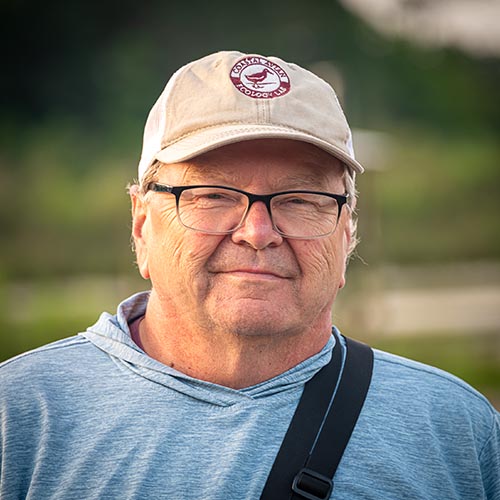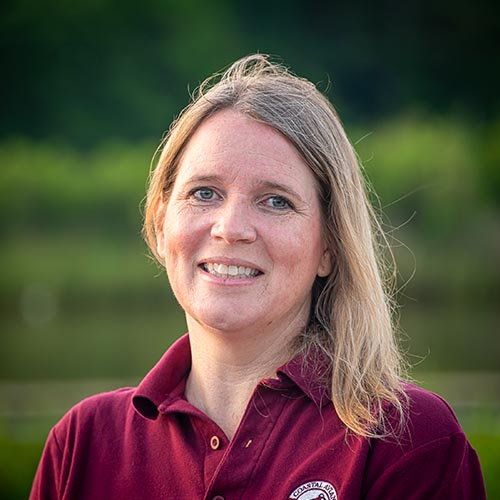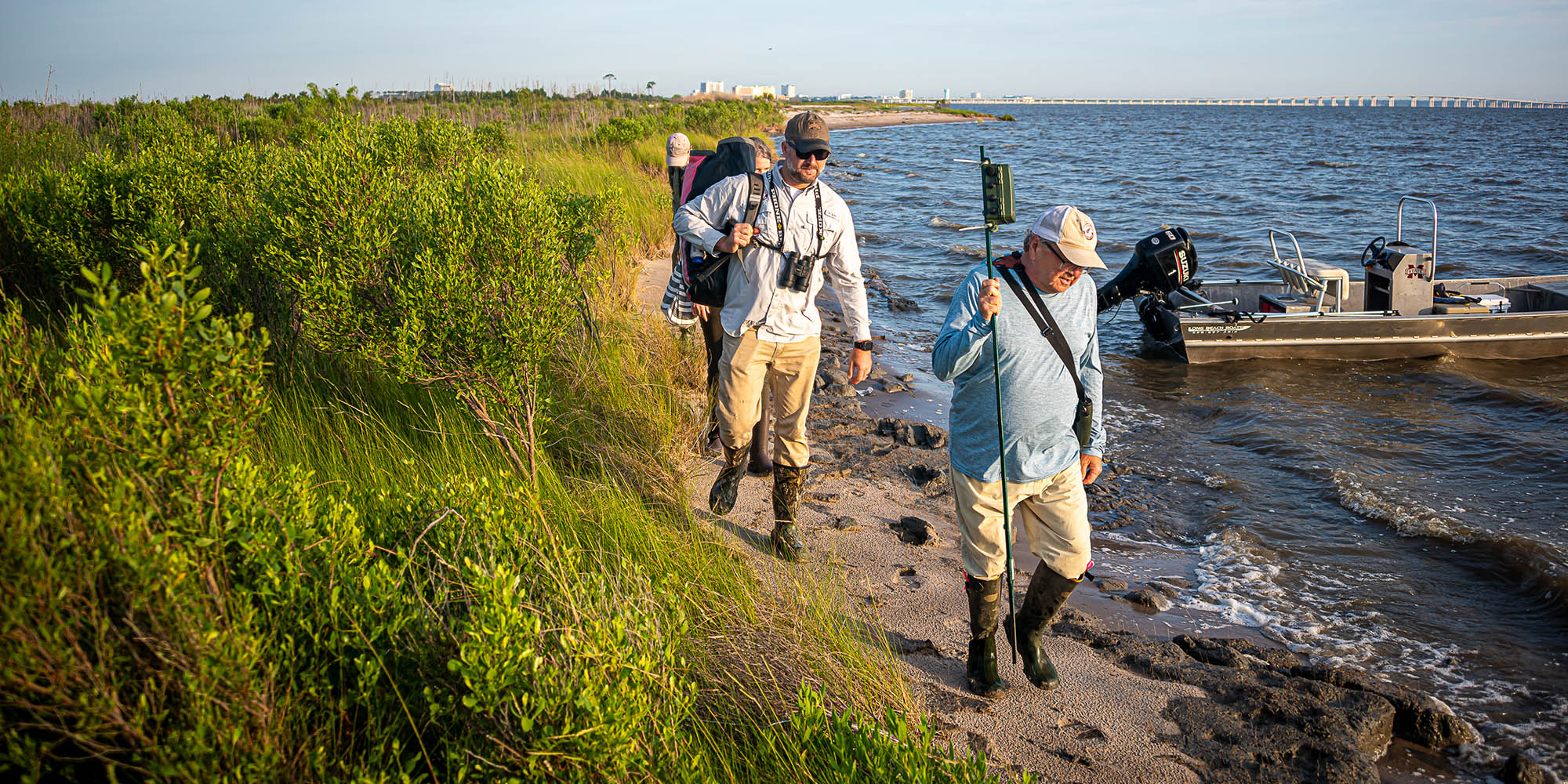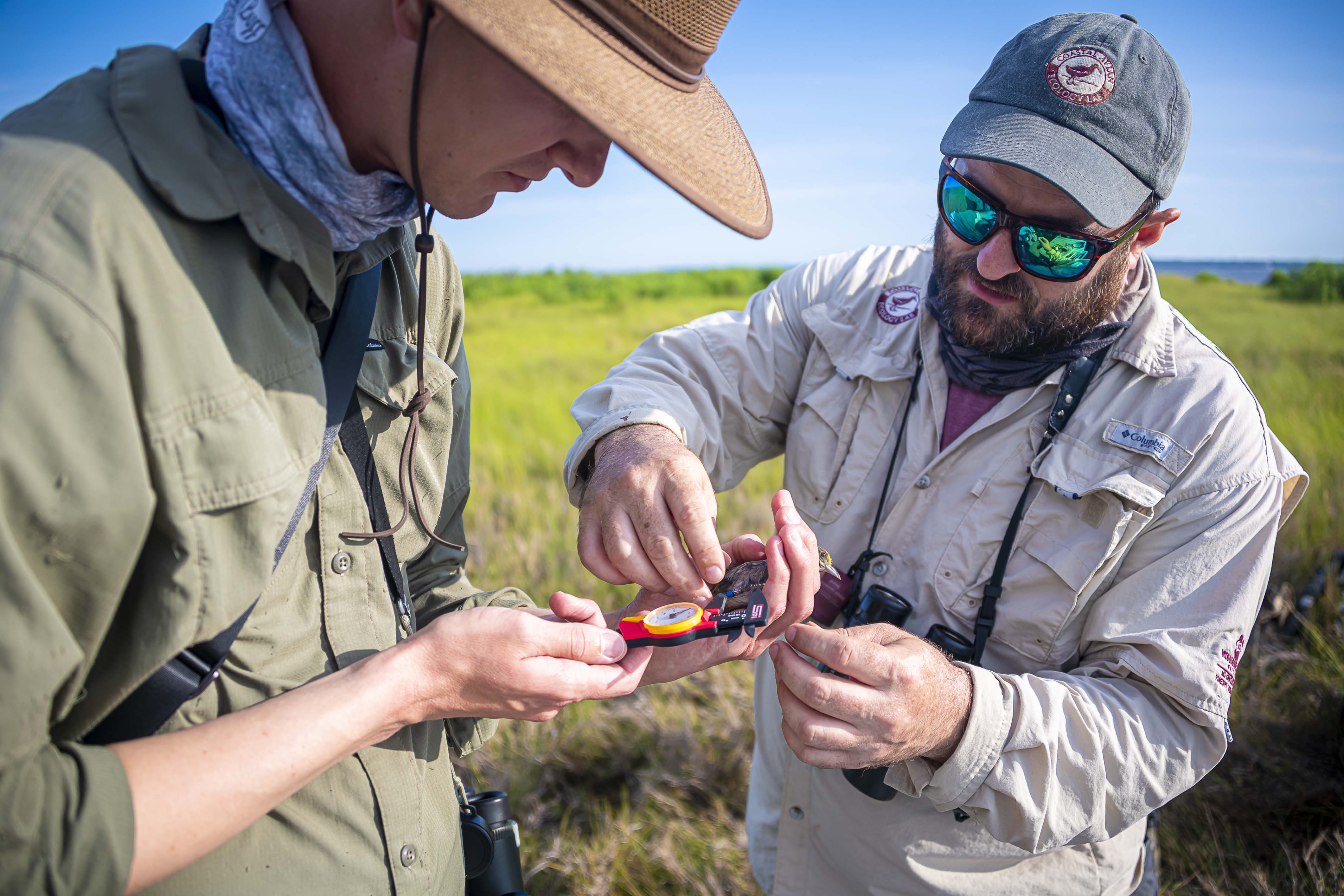The Mississippi Gulf Coast boasts a tapestry of avian life—from squawking, laughing gulls scraping the shoreline to beachcombing terns; elusive high marsh-dwelling rails; hundreds of seasonally migratory species seeking out our marshes and precious pine savannas; and many, many more. But human activity and natural disasters pose threats to the coast's unique mosaic of islands, marshes, forests, and wetlands that these birds call home.
Because birds are a critical link in the coast's delicate ecosystem, a team of avian ecologists from the Mississippi Agricultural and Forestry Experiment Station, or MAFES, homed in on three distinct systems along Mississippi's coast—marshes, beaches, and pine savannahs—which are essential to bird populations but are poorly understood.
Drs. Ray Iglay, Mark Woodrey, and Kristine Evans, associate professors in Mississippi State's Department of Wildlife, Fisheries, and Aquaculture and MAFES scientists, have collaborated to gain insights into avian activity in these ecosystems to inform conservation and land management practices in these irreplaceable landscapes.
Marsh Madness
In response to the 2010 Deepwater Horizon oil spill in the Gulf of Mexico, MAFES scientists first turned their focus to marsh birds, many of whom were visibly injured, along with their grassy homes. Iglay initiated a study, still active this year, estimating the total population of marsh birds along the coast to determine baseline population numbers.
"Every study we do is a response to the need for information," Iglay said.
"We're helping agencies like Mississippi Department of Environmental Quality, or MDEQ, better understand the coastal ecosystems that play a role in essential functions like filtering the water coming from freshwater sources into brackish and saltwater areas."
Further inland in the high marsh, Woodrey and his co-institutional team are completing their five-year long Firebird project—a study of the black rail, currently listed as threatened by the federal government, as well as the yellow rail and mottled duck living in these habitats. While land managers had concerns about the interactions of these species, the Firebird team found little overlap between the marshes used by the rails and by the ducks. From that knowledge, they are producing a manual with recommendations for land management, specifically for conducting prescribed burns on these lands.
Flocking to the Beach
Prior to the 1950s, most of Mississippi's coastline was native tidal marsh. In the '50s and '60s, the state cleared miles of grassy vegetation along the coast to make way for what is now the world's largest human-made sand beach. Today, Mississippi's beaches are home to what Woodrey estimates to be most of the state's tern population—a species that typically favors offshore beaches.
Woodrey acknowledges that there are gaps in research on management techniques for beaches, but he sees beaches—a place where human-wildlife conflict is pervasive—as a priority for conservation and management.
"Over the years, we've seen conflict between people wanting to use the beach and the cordoned-off nesting areas for terns," he said. "Working with our partner Audubon Delta, we've made some headway with stewardship and public education around those habitats, but we still have work to do."
To better understand the habits of the beach-nesting black skimmer and least tern, Iglay is leading a population dynamics study of these birds, which move back and forth from the coast up the Mississippi River and its tributaries. Iglay and his team are tracking the black skimmers with GPS transmitters and the tiny least terns with radio transmitters to monitor the birds' movements and understand where, when, and how they are using the land. When completed, the project will inform future conservation efforts along the coast and its barrier islands. The study is supported by the National Resource Damage and Assessment, or NRDA, Restoration Program, and MDEQ.
"Our population study could help us inform future opportunities for beach nourishment, creating nice, clean areas of sand for new nesting colonies," Iglay said.
Perched in the Pines
Iglay and Woodrey are collaborating on a project at the Grand Bay Estuarine Research Reserve and the Mississippi Sandhill Crane National Wildlife Refuge. The $10 million state-funded project aims to restore wet pine savanna ecosystems—characterized by clusters of pine trees scattered throughout an open herbaceous, grassy understory—to the Mississippi coast. Historically, about 90 million acres of longleaf pine savannas covered a broad swath of the Southeastern U.S., sweeping up into the Virginias and across to Texas, but decades of human activity have reduced these forests to a mere 2% of their original acreage.
In addition to supporting some of the world's most diverse plant communities and unique wildlife, pine savannas provide a winter home for migratory birds. The Henslow's sparrow, which breeds in the Midwestern and Northwestern U.S., migrates to the Gulf Coast during the winter and favors pine savannas. The scientists estimate that 25-30% of the world's Henslow's sparrow population winters in coastal Mississippi, mostly at the National Wildlife Refuge. Their study tracks how bird communities change as the pine forests are restored from current dense forests to open savannas with frequent prescribed burning.
"This project has direct applications to restoration efforts in coastal pine savanna ecosystems," said Woodrey.
"We're also seeing more coastal private landowners who are prioritizing ecosystem restoration, and our work is benefiting them as well as government and nonprofit organizations," Iglay added.
Bird's Eye View
While different bird species gravitate toward specific habitat conditions, they also travel widely. And birds are beautiful and critical pieces of the ecological puzzle, but informed conservation work requires looking at the bigger picture.
A multistate conservation effort hatched after the Deepwater Horizon oil spill resulted in a web-based tool that would provide that holistic view. The Strategic Conservation Assessment, or SCA, tool, pooled the resources and expertise of 650 stakeholders across the five Gulf states to evaluate potential projects and prioritize areas for conservation along the Gulf Coast. MSU's team, led by Evans, played a key role in developing the nationally recognized tool, which uses 26 data sets to determine the most informed and effective investments of RESTORE Act funding to re-establish and enhance healthy coastal ecosystems.
"When you're making decisions on where to invest conservation dollars, you're looking for the best return on investment," Evans said. "From our standpoint, this includes the ecological integrity of the system, improvement of biodiversity, and protection of species that may be at risk or imperiled."
Flying Forward
The MAFES colleagues have made tremendous strides in coastal research and conservation over the last 15 years, but they're also spreading their wings to carry that body of research into new territory.
Evans and her SCA team are expanding the tool to applications beyond coastal ecosystems, such as agriculture and the acquisition of land trusts, and their newly established SCA Hubs Initiative expands the tool's capabilities to other parts of the country. They are also working on an Action Impact Tool, which uses data to project future conservation action and make choices to benefit ecosystems in the next years and decades.
In addition, Woodrey and his Firebird team are proposing funding from NOAA to continue their studies for another five years.
"Birds are a great indicator of the integrity of the overall ecosystem, and studying them gives us a better understanding of how to manage our lands for a variety of interests," Evans said. "They're also fantastic ambassadors for communicating the value of the environment to the public."
This research is funded by a number of agencies, including the National Oceanic and Atmospheric Administration's (NOAA) RESTORE Science Program and National Resource Damage and Assessment Restoration Program; the Mississippi Department of Environmental Quality via the National Fish and Wildlife Foundation Gulf Environmental Benefit Fund; NOAA awards to the Mississippi Department of Marine Resources' Grand Bay National Estuarine Research Reserve and the Mississippi Department of Marine Resources; Gulf Ecosystem Restoration Council; the U.S. Fish and Wildlife Service (FWS) National Resource Damage and Assessment Restoration Program; FWS Gulf Restoration Program; and the FWS State Wildlife Grant program. Additional support was provided by the Mississippi Agricultural and Forestry Experiment Station and the MSU Forest and Wildlife Research Center.
When you're making decisions on where to invest conservation dollars, you're looking for the best return on investment. From our standpoint, this includes the ecological integrity of the system, improvement of biodiversity, and protection of species that may be at risk or imperiled.
Dr. Kristine Evans
Behind the Science

Mark Woodrey
Associate Research Professor Coastal Research and Extension Center
Education: B.S., M.S., Zoology, Ohio State University; Ph.D., Biological Sciences, University of Southern Mississippi
Years At MSU: 22
Focus: Understanding avian ecology to conserve them and their habitats
Passion At Work: I continue to pursue my passion for bird conservation to ensure future generations will be able to enjoy these amazing animals.

Kristine Evans
Associate Professor; Associate Director, Agriculture and Natural Resources, Geosystems Research Institute
Education: B.S., Wildlife Biology, Ohio University; M.S., Wildlife and Fisheries Science, Ph.D., Forest Resources, Mississippi State University
Years At MSU: 12
Focus: Avian and landscape ecology, working lands conservation, spatial conservation planning
Passion At Work: Identifying landscape and ecosystem patterns that are optimal for the persistence and recovery of birds and other wildlife species such that conservation can be targeted and effective.

Ray Iglay
Associate Professor, Faculty Liaison for Wildlife Services National Training Academy
Education: B.S., Wildlife Conservation and Entomology, University of Delaware; M.S., Wildlife and Fisheries Science, Ph.D., Forest Resources, Mississippi State University
Years At MSU: 8
Focus: Wildlife restoration on working and non-working lands, wildlife damage management, applying new technologies to wildlife conservation and management
Passion At Work: Traditional wildlife conservation approaches face new challenges that can be overcome with cohesive and attainable goals among diverse stakeholders and associated concerns whether for sustaining a species or ecosystem or decreasing the negative values associated with damaging species.


